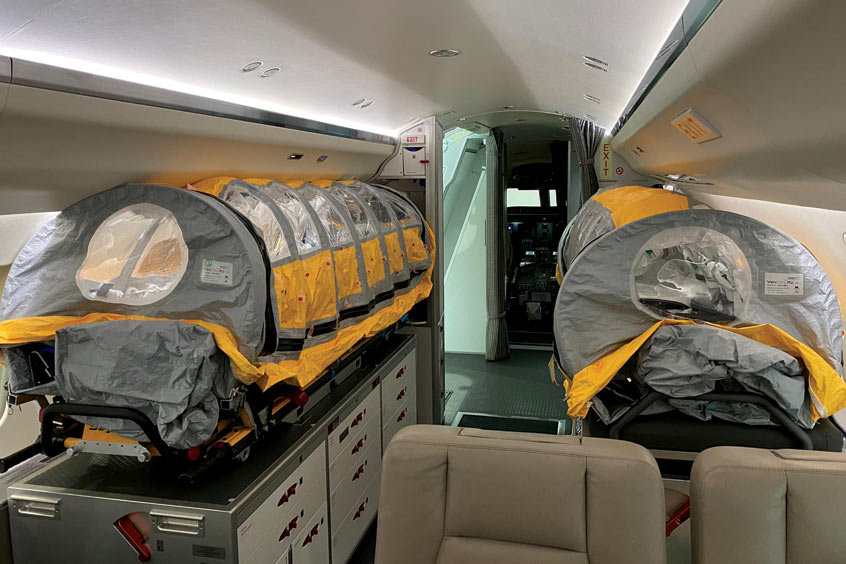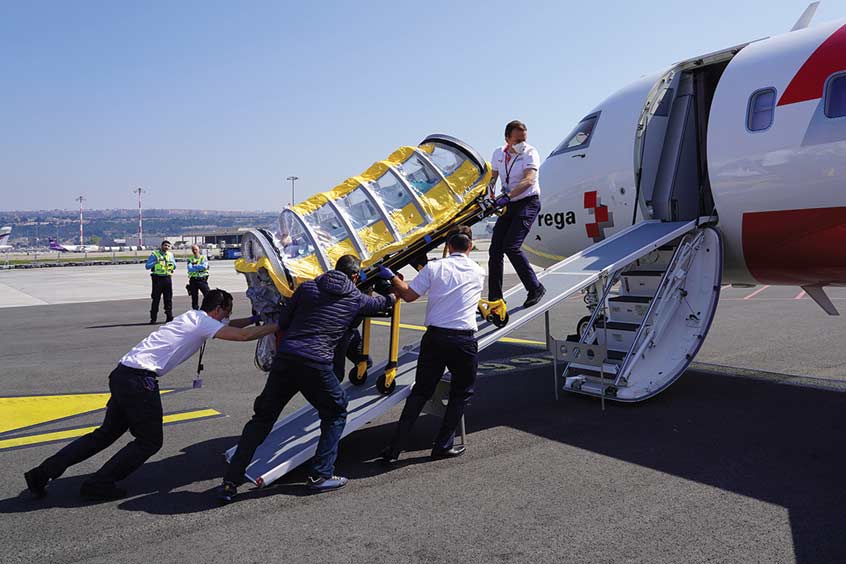ACE 2026 - The home of global charter.
 The bimonthly news publication for aviation professionals.
The bimonthly news publication for aviation professionals.



Rega's jet crews have flown around 50 patients from four continents back to their home country in the past four weeks. More than a dozen of these were COVID-19 patients or suspected cases. A patient isolation unit specially developed for the transport of infectious patients was used. The case of two patients, who could only return from the Caribbean island of St. Martin with the support of the Federal Department of Foreign Affairs (EDA), shows how great the organisational effort for repatriation is at the moment.
Organising repatriations during the Coronavirus pandemic poses major challenges for Rega's operations centre. Worldwide, entry and exit regulations are constantly changing and the head of operations must clarify with the responsible authorities before and after each repatriation whether the Rega crew can enter and under what conditions and ensure that the patient can leave the country. Nevertheless, Rega's three ambulance jets were very often in the air in March: around 50 patients who had an accident or disease abroad were flown back to their homes. Among others, patients from Brazil, South Africa, Cambodia or Marseille in France were repatriated.
In the past few days and weeks, the jet crews have flown over a dozen COVID-19 patients or suspected cases on board its ambulance jets. The organisation of some of these Corona missions proved to be particularly complex, as the case of the repatriation of a Swiss couple from the Caribbean island of St. Martin on Thursday, April 2, 2020 shows. The two were in a hospital in the French part of the island and had to be driven from there with an ambulance across the closed border to the airport, which is located on Dutch territory. Only with the support of the Federal Department of Foreign Affairs (EDA), which intervened at the embassies of the two countries, did the necessary permits for crossing the border come about.
When repatriating patients, the patient isolation unit (PIU) developed by Rega with its partners in 2015 is used in most cases, enabling the transportation of patients with contagious diseases in the ambulance jet. The Ebola epidemic, which broke out in several West African countries in December 2013, made it clear that there had hardly been a safe and reliable transport concept for highly infectious patients. In collaboration with various partners, Rega therefore developed a patient isolation unit (PIU) for airborne transport in 2015 and developed a corresponding concept. The isolation unit and the corresponding transport concept allow Rega to repatriate or transport patients with known or unclear infectious diseases with minimal personnel expenditure in their own ambulance jets relatively easily and yet safely. Before the corona pandemic, the PIU was used, among other things, in a suspected Ebola case and in patients with highly contagious open tuberculosis.
Rega chief physician Dr. Roland Albrecht, under whose leadership the PIU was developed, explains: “Before being invited onto the ambulance jet, the patient is isolated in a kind of protective tent according to a strict procedure, which prevents the risk of infection of the jet crew during the flight." Another advantage is that the jet does not have to be cleaned and disinfected afterwards, but is immediately available for a new use.
When repatriating from St. Martin, a flight with two PIUs was carried out for the first time in an ambulance jet. However, Covid 19 patients are currently also being transported without the system because the number of PIUs is limited: “Especially in the case of artificially ventilated patients, we can do without it because the closed ventilation system already sufficiently minimises the risk of infection for the crew," says Albrecht. Then the medical crew would have to wear protective suits during the flight.
If capacities are available, the three Rega jets are also available to other states and organisations. For example, on Sunday, March 29, 2020, Rega flew two and on Thursday, April 2, 2020, four seriously ill and ventilated Covid-19 patients from Bozen and Bergamo in Italy to Leipzig in Germany. Two medical Rega crews were on board each for intensive medical care during the flights, each consisting of a flight doctor and an intensive care specialist. The transfer of patients was part of a European solidarity campaign in which, for example, German hospitals that still have free intensive care beds admitted Italian and French Covid 19 patients.